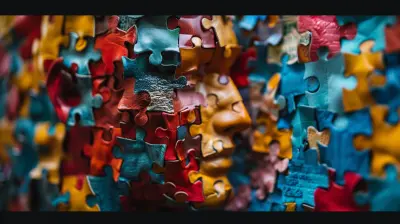Breaking Free from Emotional Stagnation: Steps to Move Forward
9 July 2025
Ever feel like you're stuck in the same emotional loop? Like your feelings are frozen in time, and no matter what you do, you're just not moving forward? You’re not alone. Emotional stagnation is more common than you’d think, and it can sneak up on anyone—especially when life throws curveballs, or nothing seems to excite you anymore.
This article is a deep dive into what emotional stagnation really is, why it happens, and most importantly, how you can snap out of it and get your emotional gears turning again.
What Exactly Is Emotional Stagnation?
Let’s be real—life isn’t always a ride on a rollercoaster. Sometimes, it’s more like a carousel that won’t stop spinning in a loop. Emotional stagnation is that feeling when you’re stuck in one spot emotionally. You’re not necessarily sad or happy. You’re just… there. Like being emotionally parked with the engine still running.It’s that unsettling numbness or dullness you can’t shake off. You wake up, go through the motions, but feel emotionally disconnected from yourself and everyone else. You might not even enjoy things that used to light you up.
Sound familiar?
Why Do We Get Stuck Emotionally?
Understanding the root causes is half the battle. Emotional stagnation often comes from unresolved emotions, burnout, trauma, or simply staying in your comfort zone for too long. Here's why it might be happening:1. Unprocessed Emotions
Think of your mind like a closet. If you keep cramming stuff in without sorting it out, eventually it overflows or becomes impossible to close. Same goes for suppressing emotions. Bottled-up feelings fester and turn into a silent freeze that shows up as emotional stagnation.2. Fear of Change
Yep, change is scary. Even when we're unhappy, routine can feel safe. Emotional stagnation loves to thrive in routines. It's like being emotionally wrapped in a warm blanket that also happens to be suffocating you.3. Burnout and Overwhelm
When your mind and body are constantly running on empty, you don't have the energy to feel. You go numb. It's your brain's survival mode when it's had enough.4. Lack of Purpose or Direction
When there’s no clear goal or meaning, our emotions wander aimlessly. No GPS? No progress. You end up parked on emotional autopilot.
Signs You're Emotionally Stuck
Before you can fix a problem, you need to know it exists. Here are some red flags:- Constant feeling of "meh"
- No excitement or motivation
- Detachment from people or things you used to love
- Feeling like you’re reliving the same day over and over
- Overthinking without any real action
- Avoiding deep emotions or hard conversations
Sounds like you? No worries—we’re getting to the good part.
Step-by-Step Guide to Break Free from Emotional Stagnation
Alright, time to shake off the cobwebs and breathe some life back into those emotions. Here’s a practical and powerful guide to moving forward:1. Acknowledge and Accept What You’re Feeling
This is step one, always. You can’t change what you don’t recognize. Name your feelings—whether it’s confusion, numbness, sadness, or indifference. It’s okay to say, "I feel stuck." That’s not weakness—that’s honesty.Think of identifying your emotions like turning on a flashlight in a dark attic. Everything suddenly becomes clearer.
2. Reflect Without Judgment
Ask yourself, what led you here? Maybe it's a job you hate, a dead-end relationship, or just too much adulting with no time for passion. Journaling helps. Get your thoughts out of your head and onto paper. Sometimes, writing is like having a conversation with your subconscious.Try prompts like:
- When did I last feel fully alive?
- What am I avoiding?
- What’s working in my life—and what isn’t?
3. Shake Up Your Routine
Routines can be comforting, but too much predictability is like emotional quicksand. To move forward, do something new—anything. Take a new route to work. Sign up for a class. Try a new hobby or even just rearrange your room.It sounds simple, but novelty wakes up the brain and stirs up new emotions. It’s like pressing the reset button.
4. Do a "Digital Detox"
Let’s face it—doomscrolling doesn’t help. Social media often feeds the illusion that everyone else has it all together, which can leave you feeling more disconnected.Set screen boundaries. Go outside. Talk to real humans. Journal. Meditate. Let your mind wander without a screen for once.
5. Feel the Feelings
One of the biggest reasons people get emotionally stuck is avoidance. Maybe you avoid sadness, anger, fear… whatever feels uncomfortable.But emotions are like waves—you have to ride them to reach the shore. Let yourself feel deeply. Cry if you need to. Scream into a pillow. Laugh out loud. Emotions are energy; let them move through you.
6. Create a Vision for the Future
What do you want your life to look like six months from now? A year? Visualizing a future where your emotions are flowing freely again helps bridge the gap between now and then.Make a vision board. Write a letter to your future self. Start mapping out small goals that help you align with that vision.
7. Reconnect With People Who Uplift You
Isolation and emotional stagnation are best buddies. But connection is a powerful antidote.Talk to someone who gets you. Not just surface-level chatter—go deep. Share how you’re feeling. Vulnerability creates space for emotional movement and healing.
8. Move Your Body, Move Your Mind
You’d be shocked how connected your emotions and your body are. Physical movement boosts endorphins, clears mental fog, and unlocks trapped emotions.Walk. Dance. Stretch. Do yoga. Go hit something at the gym if you have to. Every bit of movement counts. Your emotions will thank you.
9. Practice Mindfulness and Meditation
Stillness helps you re-attune to yourself. Mindfulness isn’t about having no thoughts—it’s about becoming the observer of your thoughts.When you sit still and breathe, you’ll notice things you’ve been avoiding or suppressing. Mindfulness helps you meet those emotions with compassion rather than judgment.
10. Seek Professional Support (And That’s Totally Okay)
If none of this feels doable or your emotional stagnation is linked to past trauma or depression, therapy is a gift you deserve to give yourself.Therapists help you unpack those emotional "closets" we talked about. Coaching or counseling isn’t a weakness—it’s a powerful step forward.
The Butterfly Effect of Breaking Free
Here’s the thing—once you start to move emotionally, even just a little, everything starts to shift. Like the first domino falling, one small step can lead to those long-awaited changes in how you feel, think, and relate to the world.Breaking free from emotional stagnation isn’t about making massive changes overnight. It’s about creating micro-movements that slowly gain momentum. Think of it as defrosting your emotional self, one layer at a time.
Closing Thoughts
You’re not broken—and you’re definitely not doomed to stay stuck. Emotional stagnation is a pause, not a full stop. It’s okay to be in this place, but you don’t have to stay here.Take one step today. Just one. Maybe it’s journaling your thoughts, getting outside for a walk, or talking to someone you trust. Whatever it is, let it be your first break in the ice.
You’ve got this. And your future self? They’re cheering you on.
all images in this post were generated using AI tools
Category:
Emotional GrowthAuthor:

Gloria McVicar
Discussion
rate this article
1 comments
Rune Wolf
In shadows deep, where feelings tread, Release the weight, let hope be fed. With each small step, the heart will sway, Embrace the dawn, and find your way.
July 31, 2025 at 2:40 PM

Gloria McVicar
Thank you! Your poetic words beautifully capture the essence of overcoming emotional stagnation and embracing hope.


